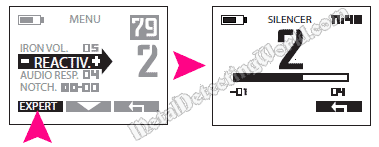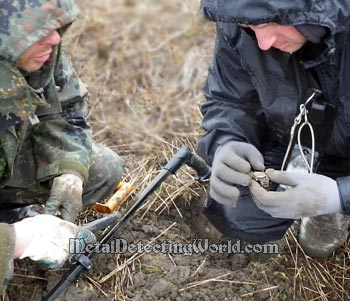XP Deus Program Settings, Features and Modes Explained, page 11
SILENCER: Function and Effects On Metal Detector's Performance
Levels: -1 to 4 (in Reactivity's EXPERT sub-menu, page 39 of the user's manual)
Because the Silencer setting is in the Reactivity's EXPERT sub-menu, it is also responsible for both the Deus' detecting range and quality of the detector's responses to "difficult" desirable targets. However, this setting's main purpose is to reduce or eliminate the "iron crackling" - audio "leftovers" of signals that are usually generated by the partially discriminated iron objects, either large or misshaped.

If the Silencer is set at 3 or 4, the Deus' detecting range for small targets will be substantially reduced, i.e.the detector will be less sensitive to small coins and jewelry at the outer limit of the Deus' Depth Penetration. And, for example, if you use high levels of the Silencer at the medieval hunt site infested with iron, most of the tiny hammered coins will be easily passed up.
This would happen because, along with muting the detector's responses to both the ground- and iron-falsing, the Silencer will also eliminate responses to deep small coins, coins on edge, tiny hammereds, gold jewelry and its fragments, etc.
So it is up to a user to decide either to dig up everything or have one's audio comfort. However, setting the Silencer at high levels would not make any difference for the medium and large-sized coins.
Setting the Silencer level at 0 or -1 during air-testing of a nail-masked 5-cent coin, which is described on a previous page, caused a not-so-good (inconsistent, with iron buzz and only 70% high-pitched in one way sweeps) response to the coin. And the coin's VDI readings were lower in values (8, 14 and 25) due to increased interference from responses to iron nails.
So, if one searches for "normal" coins - the perfect round-shaped coins, which are MASKED by the iron nails, the Silencer level should be kept above 0 or even 1.
In the v2.0 software version, the Reactivity setting is designed to take precedence over the Silencer to avoid reduction in Reactivity's effectiveness when an inappropriate value of Silencer is used. So you need to pay attention to levels of both settings when you change one or another in your search programs, especially when doing it "on the fly". If you increase Reactivity, and the Silencer is set at a low level, after you leave the Reactivity sub-menu and return to it later, the Silencer value will be increased automatically to the appropriate level. It is like this setting has a mind of its own.
NOTE: In the program Deus FAST of the v3.0 and subsequent versions, when Reactivity is set at 3, 4 or 5, the Silencer remains at -1. This fixes the issue of the Reactivity precedence over the Silencer, and allows for maintaining effective separation of targets. Besides a huge advantage in getting more valuable targets in the iron infested areas, this would cause some audio discomfort (as described above). But If you prefer the cleaner iron rejection that is characteristic for the v2.0 software, you can simply increase the Silencer setting to 2 or higher.
<If set on high levels, the Silencer would also make the Deus' responses to coins sound less crisp. Using a high setting of Silencer can be beneficial when you need to control or eliminate the iron chatter caused by high Sensitivity which you want to keep that way.

If you set the Silencer, Reactivity and Conventional Discrimination (not Tonal Discrimination) on low levels in order to "catch" small coinage, you may end up digging up lots of iron bits and small pieces that will induce high-pitched responses. So, it is all about determining a "golden medium" between those three key settings through "trial and error" process (T&E process) unless you can put up with a high level of audio "rubbish".
NOTE: the Silencer is deactivated when it is set at -1.